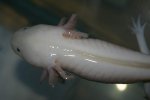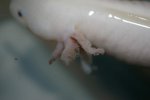milahoh
New member
- Joined
- Jan 19, 2014
- Messages
- 97
- Reaction score
- 1
- Points
- 0
- Location
- Oregon, USA
- Country
- United States
Friday I received a female leucistic axolotl in the mail. She had traveled cross county a long ways, and spent several days in her bag. I noticed her gills looked strange and even a bit inflamed the first day she arrived, and I think maybe there was an ammonia spike during shipping. Whatever the case, her gills look rough to me. Since she has arrived, she has spent almost all of her time floating on the top and hasn't eaten a thing. Is this due to the gill damage? Any advice would be appreciated. She is in a ten gallon tank alone. Gentle filter to oxygenate water. I have added melafix to deter bacterial infection.




